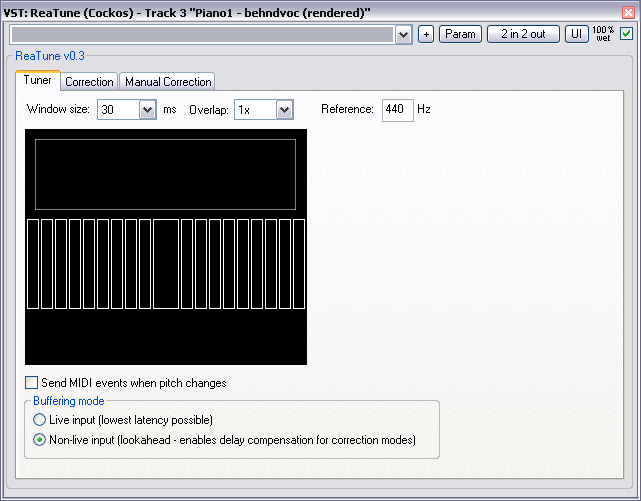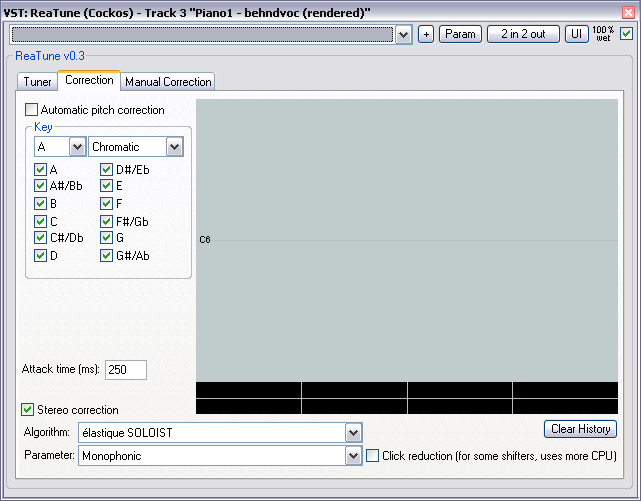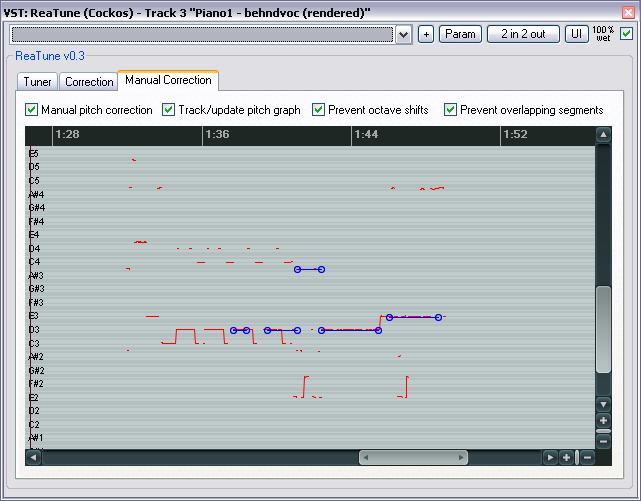ReaTune
From CockosWiki
Main Page > REAPER Documentation > Effects In REAPER > Effects
This page needs updating.
some parameters missing explanation, maybe split out the Mode-explanation
Please update the page (How to edit a page?)
If you have updated the page, or examined it and found the information up-to-date, please remove this box.
Contents |
ReaTune (Cockos)
The three tab of the ReaTune plugin are:
- Tuner - Displays the current note, useful for tuning other instruments.
- Correction - Automatic Correction
- Manual Correction - User corrects the pitch of individual notes by drawing on the graph
Tuner tab
- Window size - ??
- Overlap - ??
- Reference - The reference note, by default it's the A above middle C
- Note Display - A display of the note ReaTune is processing. The name of the note nearest to the input is displayed in the upper window. The pitch of the input is displayed in the lower window, the position of the note (left and right) giving an indication of how "in-tune" the input note is.
- Send MIDI events when pitch changes
- Buffering mode
- Live input (lowest latency possible) - Low latency and high CPU usage.
- Non-live input (lookahead - enables delay compensation for correction modes) - Non-live means recorded
Correction tab
Automatic pitch correction
- Key
- Name - A thru G#
- Mode - "The musical modes differ essentially from one another, and those who hear them are differently affected by each. Some of them make men sad and grave, like the so called Mixolydian; others enfeeble the mind, like the relaxed modes; another, again, produces a moderate or settled temper, which appears to be the peculiar effect of the Dorian; and the Phrygian inspires enthusiasm" - Aristotle
- Major - The modern major scale. (steps upwards from the tonic - Tone-Tone-Semitone-Tone-Tone-Tone-Semitone)
- Minor - The modern minor scale. (T-S-T-T-T-S-T)
- Chromatic - The Chromatic scale consists of all of the notes, from C it is. C, C#, D, D#, E, F, F#, G, G#, A, A#, B, C.
- Dorian - The Dorian mode is named after the Dorian Greeks. The Dorian mode is symmetric, meaning that the pattern of tones and semitones (T-s-T-T-T-s-T) is the same ascending or descending. The difference between the Dorian mode and the modern natural minor (Aeolian) scale is well exemplified in the relative "hardness" of the 6th note of the tune. In the modern minor scale, this note would be a semitone lower about half of the time. There, you wish you'd never asked now. However, it's not so strange as it sounds. Some songs written in Dorian are "Eleanor Rigby" by The Beatles, "Smoke on the Water" by Deep Purple, "The Way I Feel" by Gordon Lightfoot, and least surprisingly of all perhaps The "Et incarnatus est" in the Credo movement of Beethoven's Missa Solemnis
- Phrygian - This is modern Phrygian mode; It is named after the ancient kingdom of Phrygia in Anatolia. The scale underlying the ancient-Greek Phrygian tonos corresponds to the medieval and modern Dorian mode (ish). In jazz the Phrygian mode is used over chords and sonorities built on the mode, such as the sus4(♭9) chord which is sometimes called a phrygian suspended chord. For example a soloist might play an E Phrygian over an Esus4(♭9) chord (E-A-B-D-F). I'm glad I asked.
- Lydian - The Lydian mode is named after the ancient kingdom of Lydia in Anatolia. A Lydian scale based on the note C consists of the notes C D E F♯ G A and B. Alternatively, if we start on the note F, the scale consists of the notes F G A B C D E. This scale can be played on the white notes of a piano without the use of any sharps or flats (black keys) only if started on the note F (F G A B C D E).
- Mixolydian - The ancient Greek Mixolydian mode was invented by Sappho, the 7th century B.C. poet and musician. However, ancient Greek Mixolydian is not the same as modern Mixolydian. A modern Mixolydian scale is T-T-s-T-T-s-T. Songs written using Mixolydian include "Dear Prudence" and "Norwegian Wood (This Bird Has Flown)" by The Beatles, Star Trek: The Next Generation Theme (honestly) and "(I Can't Get No) Satisfaction" by The Rolling Stones.
- Locrian - This is a strange one, and that's quite an accolade in this company of already strange modes. The B Locrian mode starts on B and contains the same notes as the C Major scale. (B, C, D, E, F, G, A, B), all the white notes starting from B. It is the only modern diatonic mode where the tonic chord is diminished and therefore dissonant. Locrian is used by Jazz musicians, a bit, but not widely and you have to look hard to find music written in this mode at all. It is quite difficult to write music that is absolutely and clearly in Locrian. Sounds like a challenge to me, go for it...
- Arabian - This is also known as the major locrian scale or locrian major scale. From C it contains the notes C, D, E, F, Gb, Ab, Bb, C. To listen to major locrian you will have to dig out your copy of "Pelléas et Mélisande" by Debussy or "Nacht" by Alban Berg. You should probably do that now, before you do anything else.
- Egyptian - This is a five note, pentatonic, scale also known as Dorian Pentatonic. From C it contains the notes C, D, F, G, Ab, C. This mode is so boring it is difficult to find much information on it. I'll probably regret writing that but... there you go.
- Notes Allowed - Allows the user to modify which notes are allowed in a specific key and mode
- Attack Time - The time between the start of a note and when ReaTune starts to correct it if needed.
- Stereo Correction - Enable or disable stereo correction
- Pitch Shift Mode & Parameter - There are several modes available, each is best suited to different input signal types and each can be 'fine tuned' using the parameter drop down list. The parameters for each Pitch Shift Mode are not listed here.
- Project default - Just use the project default mode, no parameter drop-down list available.
- SoundTouch
- Dirac LE (slow)
- Low quality windowed (fast)
- élastique Pro
- élastique Efficient
- élastique SOLOIST
- élastique 2.1 Pro
- élastique 2.1 Efficient
- élastique 2.1 SOLOIST
- Clear history
- Click reduction (for some shifters, uses more CPU)
Manual Correction tab
- Manual pitch correction - Enable or disable manual correction
- Track/update pitch graph - Update graph as REAPER plays
- Prevent octave shifts - Unexpected harmonics in an audio signal can sometimes cause ReaTune to think the note as shifted up or down an octave, this option stops that - but sometimes you need it to be able to do that...
- Prevent overlapping segments - As in the picture above, the segments (blue lines) are prevented from overlapping
As you play the piece in REAPER, with Manual pitch correction enabled, this graph will fill with data. Draw blue segments to tell ReaTune what notes you would like to hear.
Main Page > REAPER Documentation > Effects In REAPER > Effects


